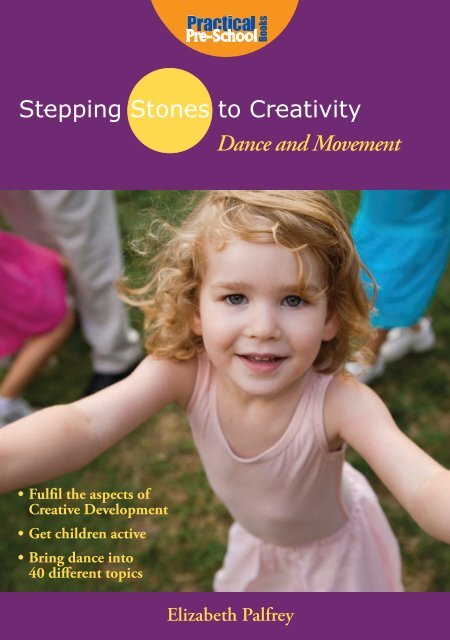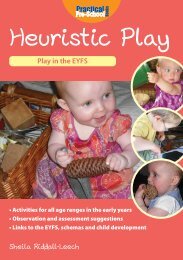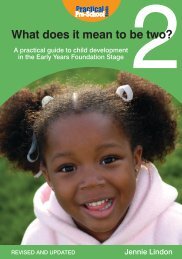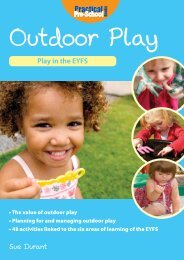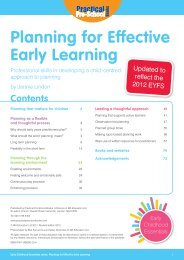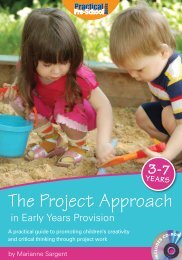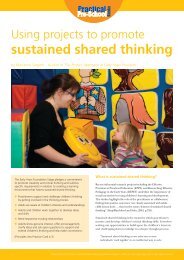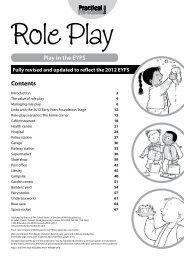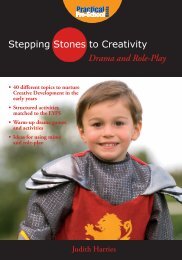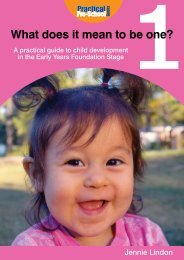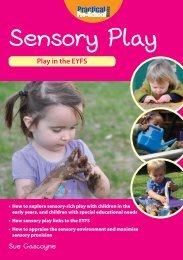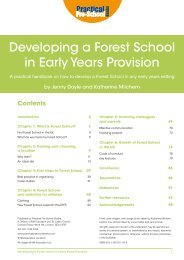SS-Dance Book.indd - Practical Pre-School Books
SS-Dance Book.indd - Practical Pre-School Books
SS-Dance Book.indd - Practical Pre-School Books
- No tags were found...
Create successful ePaper yourself
Turn your PDF publications into a flip-book with our unique Google optimized e-Paper software.
<strong>Book</strong>s <strong>Book</strong>s<br />
Stepping Stones to Creativity<br />
<strong>Dance</strong> and Movement<br />
• Fulfil the aspects of<br />
Creative Development<br />
• Get children active<br />
• Bring dance into<br />
40 different topics<br />
Elizabeth Palfrey
Contents Page<br />
Introduction to<br />
Stepping Stones to Creativity 4<br />
Exploring <strong>Dance</strong> and Movement 5<br />
Topics<br />
Animals, Autumn, Bears 6-7<br />
Clothes, Colours, Dinosaurs 8-9<br />
Families, Farms, Flight 10-11<br />
Food, Friends, Gardens 12-13<br />
Growth, Holes, Holidays 14-15<br />
Houses and Homes, Journeys 16-17<br />
Light, Machines, Materials 18-19<br />
Minibeasts, Night, Numbers 20-21<br />
Opposites, Ourselves, Patterns 22-23<br />
Pets, Pirates 24-25<br />
Puppets, Recycling, Senses 26-27<br />
Shapes, Shopping, Space 28-29<br />
Spring, Summer, Toys 30-31<br />
Water, Winter 32-33<br />
Songs suggested in this book 34<br />
Aspects of Creative Development 35<br />
Published by <strong>Practical</strong> <strong>Pre</strong>-<strong>School</strong> <strong>Book</strong>s, A Division of MA Education Ltd,<br />
St Jude’s Church, Dulwich Road, Herne Hill, London, SE24 0PB. Tel: 020 7738 5454 www.practicalpreschoolbooks.com<br />
© MA Education Ltd 2009<br />
Illustrations by Cathy Hughes. Front cover image © iStockphoto.com/Soubrette. Back cover image © iStockphoto.com/Albert Smirnov<br />
All rights reserved. No part of this publication may be reproduced, stored in a retrieval system, or transmitted by any means, electronic,<br />
mechanical, photocopied or otherwise, without the prior permission of the publisher.<br />
ISBN: 978 1 90457 581 8<br />
Stepping Stones to Creativity 3
Stepping Stones to Creativity<br />
Stepping Stones to Creativity is a series of books that aim<br />
to provide early years practitioners with a treasure trove of<br />
practical activities and resources to help develop the budding<br />
creativity of children in their care. Each book focuses on a<br />
different area of creativity, which is explored through forty of<br />
the most popular early years topics. In each topic you will find<br />
activities that support the aspects of Creative Development, so<br />
that you can ensure you are meeting the requirements of the<br />
Early Years Foundation Stage.<br />
Many of these activities can be adapted for even younger<br />
children or extended to benefit Key Stage One children.<br />
Creativity In The Classroom<br />
Creativity is an elusive term. Although great enjoyment can<br />
be taken from working with imaginative children in the Early<br />
Years who are naturally eager to explore, in practice there are<br />
some key issues which face the practitioner:<br />
What is ‘creativity’<br />
In a nutshell, it is the ability to use knowledge and skills,<br />
plus a healthy dollop of imagination, to tackle and solve any<br />
problem. It is about taking risks and being involved in the<br />
learning process. Creative thinking does not just apply to<br />
obviously ‘creative’ tasks such as art or music, but can be used<br />
in investigations in science and across the foundation stage<br />
curriculum. To develop creativity children need time, space,<br />
and multiple opportunities to experiment with materials and<br />
ideas. They also need to be encouraged to make connections<br />
between ideas as they play.<br />
How can we as practitioners make this<br />
happen for the children in our care<br />
Young children are curious by nature. They learn by exploring<br />
and experimenting and ‘having a go’. As practitioners we need<br />
to provide a stimulating environment together with lots of<br />
opportunities and of course unlimited time! Although it can be<br />
a challenge in multi-purpose buildings, a creative environment<br />
can be created by leaving art materials and musical instruments<br />
out for children to play and experiment with.<br />
Does there always need to be an ‘end<br />
product’ to creativity<br />
Practitioners and parents often both fall into the trap of only<br />
valuing an ‘end product’ as proof of creativity. How many of<br />
us have heard an anxious parent berating their young child<br />
with the words, ‘have you made me a painting this morning<br />
Tom’ Children sometimes learn to rush to the painting easel<br />
and apply a few hurried strokes of paint to appease their carer,<br />
even though they may have been involved all morning playing<br />
imaginatively and creatively in the role-play area. We need to<br />
appreciate creative play and processes as just as important as<br />
any finished artwork!<br />
What is the value of creative group work<br />
In many settings, children often work together to produce joint<br />
artwork and models, as well as singing, drama, dance and music<br />
performances. This can be seemingly problematic, as at times<br />
the individual creative process may have to be subordinated to<br />
the purpose and will of the group. However, group creative work<br />
can provide an ideal opportunity to develop children’s social<br />
and co-operative skills. More often than not it requires more<br />
imagination and creativity to work as a group!<br />
What can practitioners do to develop<br />
children’s creativity<br />
You may now be feeling how do I encourage children in my<br />
care to develop their creativity The following are useful hints<br />
for nurturing young children’s creativity:<br />
l<br />
l<br />
l<br />
l<br />
l<br />
l<br />
Provide sufficient time and opportunities for children<br />
to explore, experiment and practice their skills. Allow<br />
children time to work at their own speed. Try to avoid<br />
them being pressured by other children eager to try<br />
another activity.<br />
Some children require more encouragement to ‘have a<br />
go’ on their own. They may need you to suggest ideas,<br />
stimulate their imagination, and encourage them. Children<br />
will discover a lot through their own explorations, but<br />
unless there is an adult on hand to talk about their<br />
discoveries, learning opportunities can be missed.<br />
Children need to feel secure. They need to know that<br />
help is available if and when they need it. The tricky<br />
job is judging when to intervene if a child is struggling.<br />
Sometimes the process of problem-solving is part of the<br />
learning process, but do be prepared to model and teach<br />
new skills that children may require in order to progress.<br />
Experience will help you maintain the balance between<br />
being intrusive, and avoiding the frustration children<br />
feel when their own efforts are thwarted.<br />
Supply good quality resources – both materials and<br />
people! Challenge children by inviting artists or<br />
performers to show children their own particular area<br />
of creativity. In particular make use of talented parents<br />
who are willing to help.<br />
Encourage children to talk to each other about their<br />
work. Ask them to share how they overcame problems<br />
when constructing a model robot, or why they decided<br />
to make a loud sound at the end of the music.<br />
Try to be creative yourself! How long is it since<br />
you found time to develop your own creative gifts<br />
Challenge yourself to learn a new skill this year.<br />
<br />
Stepping Stones to Creativity
Exploring <strong>Dance</strong> and Movement<br />
The Early Years Foundation Stage<br />
The guidelines , last published in May 2008, break down<br />
creative development into four basic aspects that incorporate the<br />
five Early Learning Goals and the stepping stones as follows:<br />
Being creative – Responding to<br />
Experiences, Expressing and<br />
Communicating Ideas<br />
E.L.G. ‘Respond in a variety of ways to what they<br />
see, hear, smell, touch or feel.’<br />
E.L.G. ‘Express and communicate their ideas,<br />
thoughts and feelings by using a widening range of<br />
materials, suitable tools, imaginative and role-play,<br />
movement, designing and making, and a variety of<br />
songs and musical instruments.’<br />
Exploring Media and Materials<br />
E.L.G. ‘Explore colour, texture, shape, form and space<br />
in two and three dimensions.’<br />
Creating Music and <strong>Dance</strong><br />
E.L.G. ‘Recognise and explore how sounds can be<br />
changed, sing simple songs from memory, recognise<br />
repeated sounds and sound patterns and match<br />
movements to music.’<br />
Developing Imagination and<br />
Imaginative Play<br />
E.L.G. ‘Use their imagination in art and design,<br />
music, dance, imaginative and role-play and stories.’<br />
<strong>Dance</strong> and movement are referred to throughout the aspects<br />
of Creative Development and the importance of providing<br />
children with opportunities for both are frequently mentioned<br />
within the effective practice guidance of the EYFS. Through<br />
dance and movement children are able to express their<br />
imagination and creativity free from the fear of failure, as there<br />
is no right or wrong way to dance. <strong>Dance</strong> is a medium that<br />
enables children to build confidence in their own abilities as<br />
it continuously offers a sense of achievement. Children can<br />
respond to experiences in their own unique manner, working<br />
either individually or with others, all the while developing<br />
their ideas and creative approach.<br />
Using the activities in<br />
this book<br />
Warm Up<br />
These short sessions are designed to introduce topics to<br />
children whilst at the same time limbering them up in<br />
preparation for physical exercise. The warm up should be a<br />
time for children to become at ease within the group, as they<br />
need to feel secure and relaxed in order to have the confidence<br />
to express themselves freely. Children should feel comfortable<br />
in conveying their own interpretations of each idea.<br />
<strong>Dance</strong><br />
Each topic has suggestions for dance. Some dance is set to<br />
music, whilst others can be performed to well-known rhymes<br />
or songs. Many of the dances incorporate media and materials<br />
to enhance the experiences. These props can further develop<br />
creativity as children begin to explore and understand colours,<br />
textures, forms and space. Teacher input is a great way to<br />
encourage movement but be careful not to over demonstrate<br />
aims and intentions, as this may limit children’s own thoughts<br />
and expression.<br />
Movement Games<br />
Games are linked to the topics and provide time for the group<br />
to play together imaginatively, often involving role play and<br />
some use of props. Almost all can be played both indoors or<br />
outdoors, adding further learning opportunities and additional<br />
dimensions.<br />
Cool Down<br />
It is critical that children<br />
have sufficient time to<br />
relax after physical play, and<br />
this is exactly the aim of<br />
each cool down.<br />
These activities should<br />
be conducted in a calm<br />
environment away from<br />
distractions wherever<br />
possible, ensuring<br />
appropriate room<br />
temperatures are<br />
maintained with<br />
adequate ventilation<br />
and access to fresh<br />
drinking water.<br />
Stepping Stones to Creativity 5
animal being shown. As the children’s confidence grows stop<br />
the music frequently and provide a wider range of animals for<br />
them to impersonate.<br />
Cat & Mouse<br />
Music is played and the children squeak and move<br />
around the room like mice. When the music is stopped<br />
the mice must remain perfectly still. Any mouse moving is<br />
immediately caught by the cat – an adult or child chosen<br />
beforehand.<br />
Cool Down<br />
Sleeping lions<br />
Children pretend to be lions settling down for an<br />
afternoon nap in the cool shade of a big tree. Once asleep they<br />
must remain perfectly still. Any lion caught moving is out. Try<br />
to catch the lions out by making them laugh or smile, wriggle<br />
or fidget!<br />
Animals<br />
Warm Up<br />
Who am I<br />
Children take it in turns to perform animal impressions<br />
with sounds e.g. a laughing hyena, a snapping crocodile, a<br />
howling monkey or a roaring lion.<br />
<strong>Dance</strong><br />
Play Camille Saint-Saens “Les Carnival Des<br />
Animaux”.<br />
The music reflects the following animals;<br />
l Lions<br />
l Tortoise<br />
l Elephants<br />
l The aquarium<br />
l Donkey<br />
l Fossils<br />
Encourage the children to listen to the music as they move<br />
about. How does the music remind them of the animal it<br />
represents and how can they move like the animal<br />
Movement Games<br />
Musical Animals<br />
Play some of the children’s favourite music and invite<br />
them to dance about however they choose. Explain that when<br />
the music is stopped a picture of an animal will be held up and<br />
the children can stop dancing and start performing like the<br />
Autumn<br />
Warm Up<br />
Autumn trees<br />
Imagine you are a tree standing tall with branches out<br />
wide. What type of tree are you What animals live in you<br />
Gently sway about in the breeze. Maybe a strong storm is<br />
coming Encourage the children to shake their branches to<br />
loose their leaves.<br />
<strong>Dance</strong><br />
Dingle Dangle Scarecrow<br />
Children love to perform this lively action song.<br />
Vivaldi’s L’Autumno<br />
You will need a copy of Vivaldi’s classic, “The Four<br />
Seasons”. “L’Autumno” (Autumn) aims to represent the<br />
happiness the season brings with everybody being made to<br />
forget their cares and to sing and dance as they celebrate the<br />
pleasure of a bountiful harvest. As you listen to the music<br />
encourage dance that reflects celebration.<br />
Five Fireworks<br />
Stand five children in a row on a bench or a step<br />
– somewhere safe for them to jump off into the night sky!<br />
Say the following rhyme:<br />
Five fire works standing in a row<br />
(Children stand with arms above heads pointed like a rocket)<br />
6<br />
Stepping Stones to Creativity
Looking for adventure<br />
Ready to go<br />
5, 4,3,2,1 blast off<br />
WOOOSH away one goes<br />
(One child jumps from the bench and fl ies into the night sky)<br />
Four fire works...........and so on.<br />
Movement Games<br />
Hot potato<br />
Sitting in a circle give the children a potato (a bean bag<br />
will do just as well). As music is played the potato is<br />
passed from child to child around the circle. When the music<br />
stops the child holding the potato must lie down on the floor<br />
where they were sitting. The winner is the last child sitting up.<br />
Cool Down<br />
The Mendi Tree<br />
This is a traditional Indian story for Hindu weddings<br />
and celebrations and is intended to be acted out in pairs.<br />
Take red and gold of the morning skies from the leaves of the<br />
Mendi Tree (Reach up pretending to take the leaves)<br />
Make patterns from these special dyes (Mime stirring the leaves<br />
into a paste)<br />
On the hands of you and me (Point to your partner and then<br />
yourself)<br />
Take little hands, and decorate (Hold hands out to your partner)<br />
With mango, leaves, and curls (Take turns to draw patterns<br />
using fingers on each others hands)<br />
<strong>Dance</strong><br />
Perform a Song<br />
Invite children to perform the song “The Bear went<br />
over the Mountain”, “We’re going on a Bear Hunt” or “If you<br />
go down to the woods today” providing appropriate props and<br />
encouragement. Don’t demonstrate too much as the idea is to<br />
promote children’s own creativity.<br />
Bare Necessities<br />
Play the music “Bare Necessities” from Disney’s Jungle<br />
<strong>Book</strong> and allow the children to create their own dance to<br />
match the groovy beat of the music.<br />
Movement Games<br />
Goldilocks and the Three Bears<br />
Similar to “What’s the time Mr Wolf” Three children<br />
are chosen to be Daddy, Mummy and Baby Bear. The bears<br />
stand at one end of the room or garden with all the other<br />
children at the opposite end. The children call out “Who is<br />
home today” and the bears call out Daddy, Mummy or Baby.<br />
The children then take a step forward. If the bears call out<br />
“Goldilocks” they chase the children until three are caught.<br />
These three become the new bears.<br />
Cool Down<br />
<strong>Pre</strong>tend to be a bear getting ready for hibernation.<br />
Gather the things you need to make a warm soft bed<br />
in your cave. Make sure you have eaten a big supper and settle<br />
down, stretching and yawning before you drift into a deep<br />
sleep. Encourage the children to describe their actions, what<br />
sort of a bear are they, what things are they gathering, what are<br />
they eating What is the weather like<br />
A paisley pattern of your own with Mendi shapes and swirls<br />
(Hold partners hand and turn slowly)<br />
Bears<br />
Warm Up<br />
What Bear am I<br />
Ask the children to think of as many different types<br />
of bears as possible including character bears. For example<br />
Polar bears, Grizzly bears, teddy bears, Winnie the Pooh and<br />
Paddington Bear. Invite the children to do a short performance<br />
of how their chosen bear might move and sound. Can the<br />
other children guess what or who they are pretending to be<br />
Stepping Stones to Creativity 7


